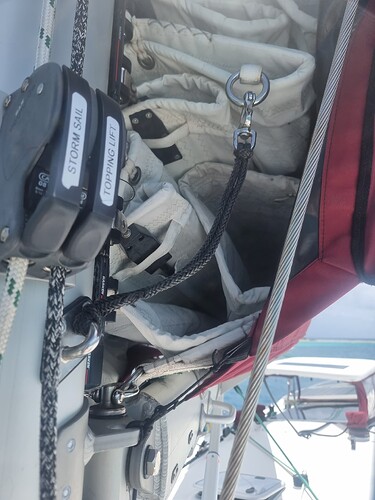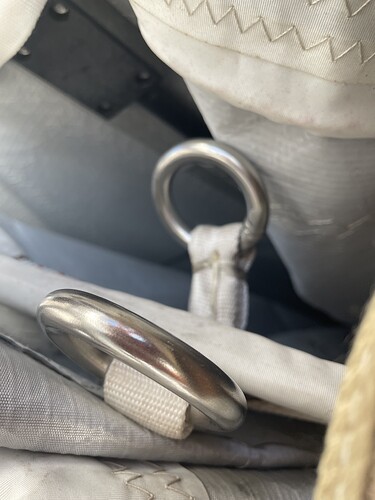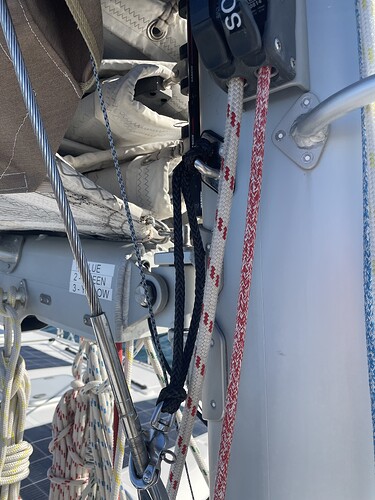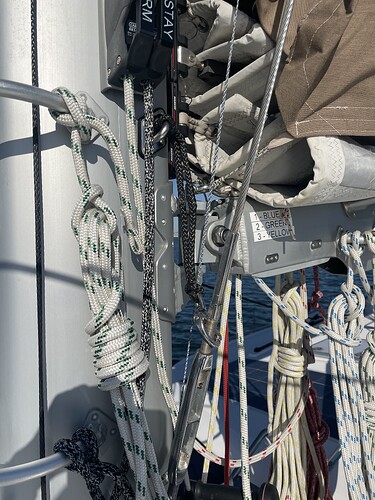This was the fourth time our boat rounded Cape Hatteras, often referred to as the “Graveyard of the Atlantic.” The first three passages were relatively smooth, but this time, the conditions tested our knowledge more than we expected.
The weather router we hired described the window as “brisk sailing, with conditions a bit saltier than most would prefer.” With the season winding down, weather windows were shrinking, and we decided to take the opportunity. The forecast predicted 8-10 foot seas with long periods, which is very manageable. The real challenge, however, would be the 30-knot gusts hitting us on the beam.
As we approached Hatteras, about 30 minutes out, we made the decision to reef down to the third reef. This would make the sail as small as possible and allow us to handle the strong winds. With the third reef, we could safely sail in 30-35 knots of wind.
To our surprise, Carolyn discovered that the reefing Dyneema line wasn’t long enough to attach to the third D-ring on the sail. Since we’d never used the third reef before, we hadn’t tested this setup. It seemed the Knysna Yacht Company hadn’t either!!
We switched to the second reef, which is rated for winds of 25-30 knots. We kept a close eye on the chartplotter to avoid exceeding the limits, knowing that pushing too far could result in a blown-out sail, shredded by the wind.
Once we rounded Hatteras, the boat truly began to fly. It was dark by then, but we were hitting speeds of over 10 knots, which increased the apparent wind from 20 knots of true wind to more than +25 knots. We’d just had the bottom cleaned, which allowed us to slip through the water effortlessly and gain more speed. At times, the bow would bury into the waves, and strong winds would catch the crests, sending water flying across the deck and over the helm.
Later we realized we hadn’t secured the anchor bridle and snap shackle to the deck. Normally, if not attached and had it fell over board it would just drop into the water, but at our speed, it was skipping and bouncing across the surface. The 3-5 pound stainless steel snap shackle was now a potential hazard, threatening to puncture the hull or crack the emergency exit. We had no choice but to retrieve it immediately.
With 20-25 knot winds, 8-foot waves, and complete darkness, we had to act quickly. Earlier, I’d luckily set up a safety jackline running from the bow to the stern. Carolyn donned her life vest setup with electronic EPIRB, attached herself to the jackline, and I steered the boat into the wind, lowered the jib, and prepared in case she was knocked overboard. Unfortunately, this forced us head-on into the waves.
Carolyn moved to the bow, crossed the trampoline, and hung over the edge the front of the boat to grab the line—facing 20+ knot winds and 8-foot swells, all in the dark. As she made her way back, we hit two large waves, and she had to hug the mast to stay on her feet.
Later, we would encountered winds over 30 knots. Since we couldn’t reef further, we decided to take the sails down. As I furled the jib, the boat slowed, and with it, the apparent wind also decreased—a valuable lesson learned. The jib had essentially been our engine that night with the sail configuration we had set up. When we reduced it, our speed reduced and with that the apparent wind dropped, and everything became more manageable. Damn, we’re learning as we go!
We continued sailing through the night, constantly adjusting to the apparent wind. This would take 100% of our concentration, very tiring.
We finally arrived at our port the next evening. We always seem to arrive after dark, but having been here before, I thought we’d be fine. However, in the dark, it was hard to see the red and green guiding lights. As we rounded the bend toward the anchorage, we were met with a sea of boats, all brightly lit with red, green, and blue lights. They were gathering for the Christmas boat parade. While the festive mood was unmistakable, being sleep-deprived and utterly exhausted, I couldn’t help but think how tempting it would be to relax on a sofa watching Oprah, instead of still being out here on the boat. It was not one of my best moments. I was done. We had completed an extremely challenging passage—just the two of us, one I hope we do not repeat again.



